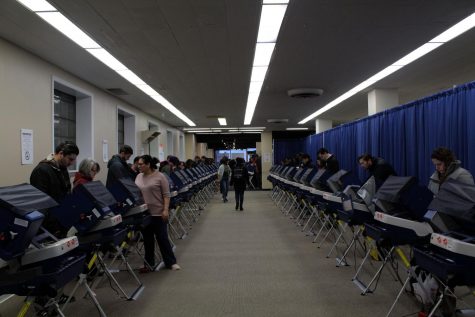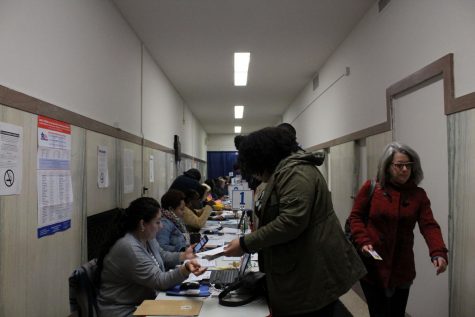JEA National Contest Fall 2018
Advanced voting turnout gives first look at Midwest midterms
November 2, 2018
It’s been a long time coming, but it’s finally here: the midterm elections have arrived via advanced ballot voting, giving America it’s first peek into Tuesday’s results.
The 2018 midterms have attracted a lot of attention in light of the 2016 generals. In the Midwest, the current political climate has caused a skyrocket in advanced voting, showing for the first time numbers more often seen in presidential elections. Most notably, high numbers have become increasingly present in the Midwest states of Kansas and Illinois.
According to the U.S. Election Assistance Commission, in the 2016 generals, — serving as the first pinpoint in a trend that has rapidly increased since — more than one-fourth of voters in Illinois and Kansas voted by advanced ballot.

Citizens of Chicago begin advanced voting using electronic voting terminals.
In big cities, such as Chicago, Illinois, the most significant changes shown in current advanced ballots regard the increasing gender gap and youth votes.
As of Nov. 2, Chicago numbers show 54 percent of women making up advanced voters, and another 59 percent making up those that vote by mailed ballot, according to Jim Allen, Chicago Board of Elections spokesperson.
Gender isn’t the only wind of change about in the Windy City, youth votes are attracting attention as well. According to Allen, young voter turnout is still quite low, as it still isn’t quite as high as those ages 55 and up; however, youth numbers are still significantly increased.
“There is a smaller gap between the ages of 25 and 37,” Allen said. “We used to talk about the age gap in the double digits, but now we see them coming back in the single digits.”

Chicago residents fill out registration forms before voting for the United States House of Representatives and for the U.S. Senate.
These major changes that will affect social and political conditions do not stop with the large Midwest cities. Here in Manhattan, Kansas, voter turnout, specifically advanced voter turnout, is soaring.
According to state reports, during the 2014 midterm elections, advanced voting turnout in Riley County hit a little over 5,000 by the end of the midterms.
However, this year, Riley County Clerk’s office reports advanced voting numbers reaching as high as 6,498 on Nov. 1 — a number more often seen in presidential elections.
“It’s a record turnout for Manhattan,” County Clerk Rich Vargo said. “It’s unprecedented.”
According to Vargo, this turnout is in part due to the special question on the ballot this year regarding the USD 383 bond referendum, causing a spike in young-family voter turnout.
While the numbers have not yet come in on age and gender for Kansas counties, Kansas is set to expect a wide number of women and youth to turnout due to the questions on Kansas education funding, as well as the twister-like political climate that is beginning to settle in the Sunflower State.
For Manhattan voters, the midterms follow just five days after Westboro Baptist Church protested the LBGTQ+ community of Manhattan High and one month after a Trump rally in the capital that ensued in an immense protest while the president endorsed heavily-Republican gubernatorial candidate Kris Kobach. This only increased political tensions among voters.
While tensions stir and votes are cast, the Midwest, with a slew of political and social changes, enters the waiting game that is the midterm result.

